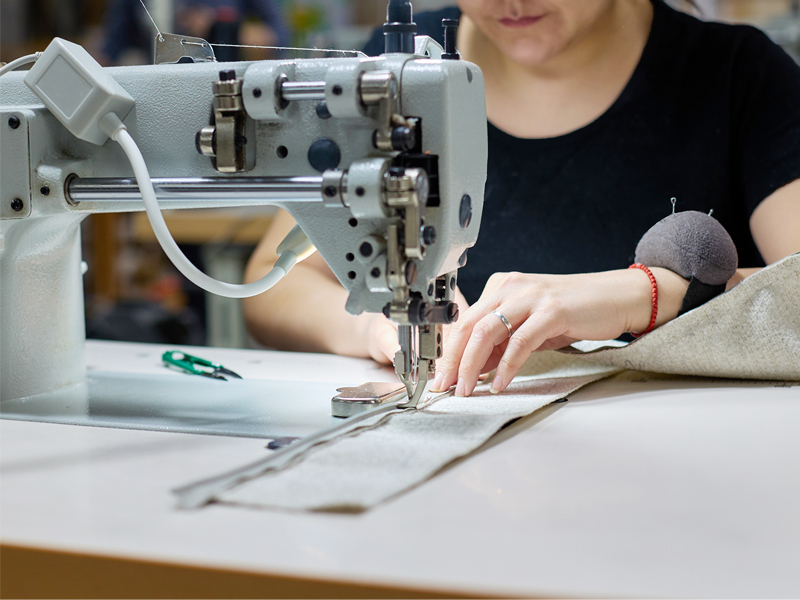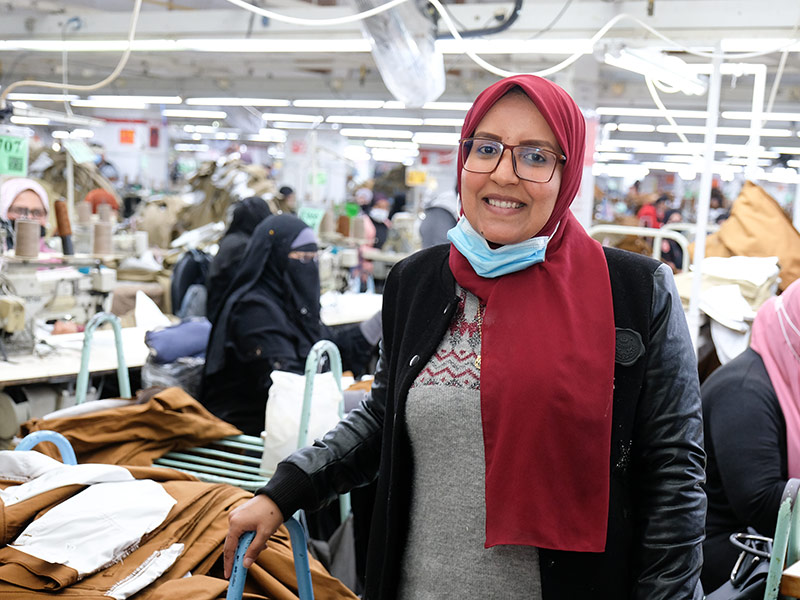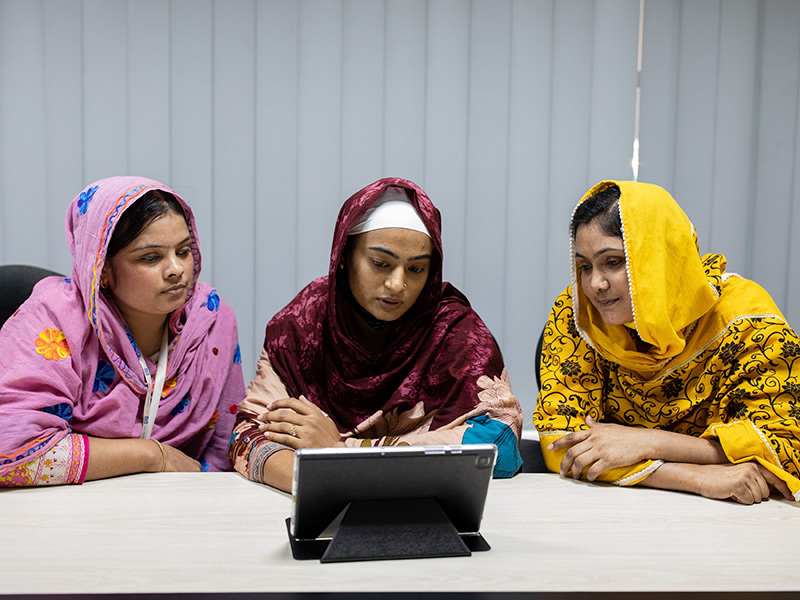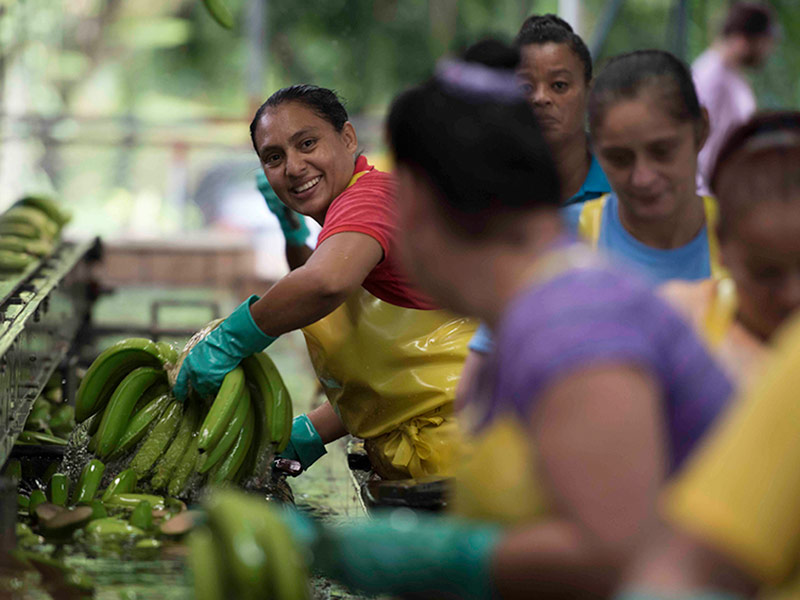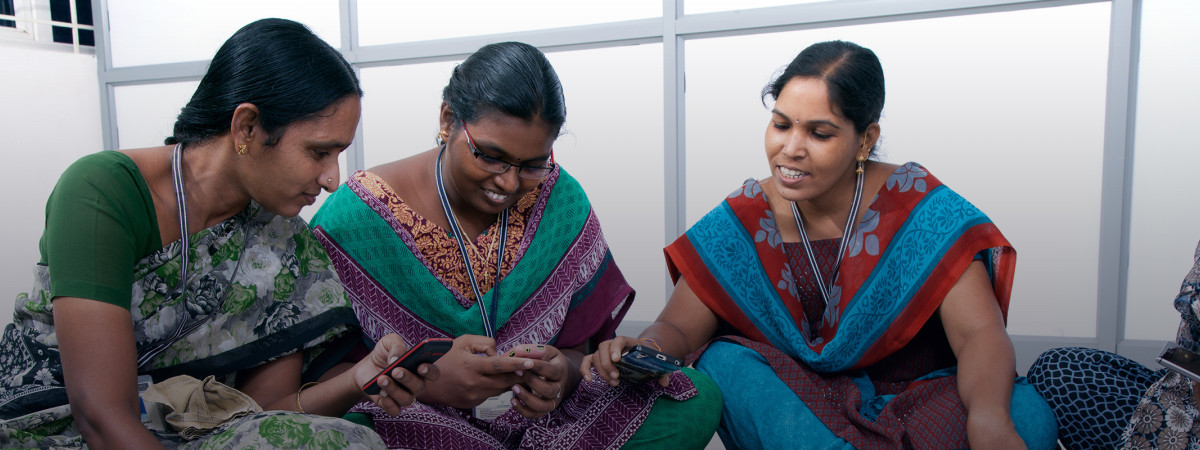
Please note: Currently the dire developments of the COVID-19 pandemic in India are preventing HERproject from implementing program activities in workplaces in India. We are closely following the situation and extending support to our team and implementing partners in India. If you would like to support, here are some ideas: https://mutualaidindia.com
The uneven global deployment of COVID-19 vaccines is a stark reminder that the existence of a life-changing innovation doesn’t translate to universal access to and enjoyment of its benefits. Similarly, the access to digital technology is far from equally distributed.
Globally, women have less access to technology, mobile phones, and internet connectivity. In low- and middle-income countries, 165 million fewer women than men own a mobile phone and over 300 million fewer women than men access the internet on a mobile. The mobile gender gap is widest in South Asia: in countries like Bangladesh, women are 52 percent less likely than men to use mobile internet.
Against this backdrop, HERproject launched our new program HERessentials, which aims to help bridge the digital gender divide among workers in global supply chains. The program, delivered digitally through a tablet-based learning app, provides female and male workers with critical knowledge and resources on health, financial inclusion, and gender equality in times of crisis. Through HERessentials, workers will also get the opportunity to become more comfortable using digital technologies.
To explore the challenges of leveraging digital approaches, we invited Sonia Jorge of Alliance for Affordable Internet (A4AI) and the Web Foundation and Mariana Lopez of the GSMA Connected Women Programme for a discussion earlier this year.
We explored three key insights that are applicable to stakeholders working to bridge the digital gender divide.
1. Access to devices is only the first of many steps
Ensuring that women have access to mobile phones and SIM cards is the first step towards closing the digital gender gap.
GSMA research highlights that the most immediate hurdle for women having their own mobile phone is the affordability of handsets. Data and service fees are also an issue. A4AI research shows that nearly 2.5 billion people live in countries where the cost of the cheapest available smartphone is a quarter or more of the average monthly income. Women in many countries are more likely to have lower quality handsets and to share these with their husbands, children, or other family members. Often, this results in them having less exposure and time to learn how to use and benefit from mobile phones.
Affordability is key, but so is having the skills and confidence to use digital technologies. GSMA research shows that a lack of digital literacy and skills is the key barrier preventing female mobile owners from adopting mobile internet. HERproject shares the same experience: without training, digital services may offer little to no benefits. For instance, in 2017 the garment industry in India digitized wages, but three years later HERproject research showed that male and female workers still withdrew all their wages on payday.
Introducing women to digital devices in an open and safe training environment, such as with HERessentials, is one way to kick start their journey to becoming connected. After receiving training that addresses financial literacy and social norms in a risk-free environment through the HERfinance Digital Wages programs, we have seen workers in Bangladesh becoming active mobile money users. Post-training, women were conducting around eight mobile money transactions per month.
As with all behavior change, introducing technology is about providing both a clear case on its benefits to women, as well as the tools and skills to reap those benefits. This requires demonstrating the benefits of technology, mobile, internet; supporting women with the knowledge required to make empowering decisions and trusting them to decide how they want and need to use technology.
2. Take responsibility for women’s safety
Safety and harassment fears are significant barriers that inhibit women from benefiting from or even wanting to use a mobile phone. For example, while mobile money can offer more privacy when conducting financial transactions, women are less likely to become active mobile money customers if they experience harassment from mobile money agents. The online environment also brings risks, including violence, fraud, surveillance, identity theft, misuse of personal images and data, exposure to explicit content and more.
For these reasons, enabling women to use digital technologies also entails supporting them to understand how to use them in a way that is safe and secure. For example, by helping them to protect their data; from not sharing personal information such as bank details to using security settings that allow content to be shared only with known contacts.
This also includes recognizing and addressing online harassment: what it is, where it happens, and what to do (including how to block and report inappropriate content and behavior).
Finally, it also requires that companies and governments take action to address online gender-based violence. The Web Foundation has led a series of workshops to assess how product and policy solutions impact women’s safety online. It is now working with stakeholders, including companies, to design policies that support safe online experiences.
3. Bring men along from the get-go
Frequently, the hurdle for women not using technology sits closer to home. Many women have limited autonomy and power to decide whether or not to access mobile phones and the internet, with male family members often acting as gatekeepers.
This can be about protection: women can be seen as vulnerable to corruption by the negative side of the internet, which some see as a potential risk to the family’s reputation. It can also be about control or power dynamics: Mobile phone ownership can promote independence and, in turn, disrupt the status quo and traditional views of women’s roles in the household. For these reasons, men may try to discourage and prohibit female family members from owning and using mobile phones.
As such, it is important to support men’s understanding of the value of a female family member’s access to phones and the internet. What’s key here is making clear how the whole can family benefit from a woman’s access to technology.
GSMA research in South Asia found that use cases that have both personal appeal for women and externally justifiable rational benefits are particularly important to help persuade gatekeepers that access to mobile internet will benefit the entire household. Examples include video calling (especially for those with family living far away or overseas), learning a productive new skill (e.g. sewing, cooking), helping with their children’s education or contributing to household income (e.g. through information to improve farming).
Equal access is not a zero-sum game. It benefits everyone. It is therefore necessary to involve and include men in training sessions and make them aware of the relevance of mobile services for women’s day-to-day lives. For this reason, HERessentials trainings are implemented with both men and women workers, demonstrating the usefulness of digital tools to all.
Empowering women through digital technology benefits businesses, economies and societies
The commercial potential of bridging the digital gender divide is enormous. Women are half of the potential market for businesses. Over five years, closing the gender gap in mobile ownership and internet use in low- and middle income countries could deliver US$140 billion in additional revenue to the mobile industry. HERproject is testimony that training women workers on using digital services in the workplace has positive impacts both for them and their workplaces. HERessentials is now building on this work and contributing to build up women worker’s digital skills as the program expands from Bangladesh to India, Pakistan, and Central America.
The COVID-19 pandemic has further highlighted the cost of not having digital skills and being excluded from the online world. There are risks in going too fast, and we need to continue to evaluate and address the existing barriers and new challenges that women face to be part of the digital future. At the same time, the pandemic has shown that the risk of not going fast enough is greater than ever: inclusion cannot wait.
Topics
Collaborative Initiatives
Let’s talk about how BSR can help you to transform your business and achieve your sustainability goals.



